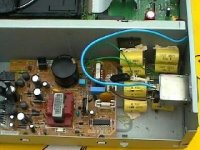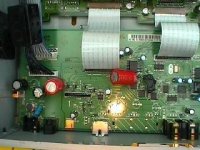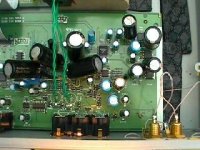output caps audio
Hello All,
I searched for a description to find exactly what caps I would have to change on the audio output. the only information I found was to replace the output caps with Black Gate NX serie, 100 uF.
My question is which caps are to be replaced, how do I recognise them and these black gates seem to be 6,6 volt is this the correct value? I could not find a confirmation on this.
Regards and thanks,
Redfox
Hello All,
I searched for a description to find exactly what caps I would have to change on the audio output. the only information I found was to replace the output caps with Black Gate NX serie, 100 uF.
My question is which caps are to be replaced, how do I recognise them and these black gates seem to be 6,6 volt is this the correct value? I could not find a confirmation on this.
Regards and thanks,
Redfox
Output caps
Hi Redfox,
You can replace these output caps by Black Gates N's (not the NX), 16V 100uF. If you want to go further and enhance the sound by a big margin you can replace them with Black Gate N's 16V 47uF in super E-cap configuration. So you need two caps per channel in series.
Saffier
to replace the output caps with Black Gate NX serie, 100 uF
Hi Redfox,
You can replace these output caps by Black Gates N's (not the NX), 16V 100uF. If you want to go further and enhance the sound by a big margin you can replace them with Black Gate N's 16V 47uF in super E-cap configuration. So you need two caps per channel in series.
Saffier
Some new pictures
As some of you requested pictures to visualise my tweaks:
here they are (sorry for the bad quality of the pictures). Later on I'll post better pictures.
Saffier
www.picturetrail.com/s.brull
As some of you requested pictures to visualise my tweaks:
here they are (sorry for the bad quality of the pictures). Later on I'll post better pictures.
Saffier
www.picturetrail.com/s.brull
Attachments
Saffier
What film caps have you used in the power supply, and how did you use them? Are they just cupling caps, or replacement of e-caps?
What film caps have you used in the power supply, and how did you use them? Are they just cupling caps, or replacement of e-caps?
SMPS upgrade
The film caps in the SMPS are MKP I 1500V 0,22 uF "snubber" caps to dampen switching noise. Two of each around every BYV96E diode. So everything you see on the right side in the picture above is just the replacement of the rectifying bridge.
This is a huge improvement, more tube like sound , much more clean and better dynamics.
Saffier
The film caps in the SMPS are MKP I 1500V 0,22 uF "snubber" caps to dampen switching noise. Two of each around every BYV96E diode. So everything you see on the right side in the picture above is just the replacement of the rectifying bridge.
This is a huge improvement, more tube like sound , much more clean and better dynamics.
Saffier
Ok, saffier it is now getting clear to me. You used the space near the main inlet to place the supe e-caps and wired them to the place where the output caps where.
Did you use any special wire?
Many thanks for the information I've been searching several days now 🙂
Did you use any special wire?
Many thanks for the information I've been searching several days now 🙂
Caps
Redfox,
Everything in the power supply compartment is for the SMPS, so no super e-caps as coupling caps in the SMPS.
The super e-caps are mounted on the wooden block between the AV board and the drive unit. I used silver/teflon wire.
Saffier
Redfox,
Everything in the power supply compartment is for the SMPS, so no super e-caps as coupling caps in the SMPS.
The super e-caps are mounted on the wooden block between the AV board and the drive unit. I used silver/teflon wire.
Saffier
Re: Output caps
Have you ever tried a good film cap in the output as well (in general, not just the 963). There are some who think avoiding electrolyt caps in the signal path is the preferred way, even if it is Black Gate.
You mentioned this before, but I forgot to ask then. What is this 'super E-cap configuration'? Or does it just mean to caps in series? How do you arrange the poles?saffier said:If you want to go further and enhance the sound by a big margin you can replace them with Black Gate N's 16V 47uF in super E-cap configuration. So you need two caps per channel in series.
Saffier
Have you ever tried a good film cap in the output as well (in general, not just the 963). There are some who think avoiding electrolyt caps in the signal path is the preferred way, even if it is Black Gate.
Re: SMPS upgrade
Did you also try the BYV96E without the caps. I read elsewhere that the BYV96E does not really need them because the are soft recovery diodes and using the caps might introduce noise.saffier said:The film caps in the SMPS are MKP I 1500V 0,22 uF "snubber" caps to dampen switching noise. Two of each around every BYV96E diode.
Super E-Cap
Please read the following article on the Black Gate site:
http://www.blackgate.jp/english.htm
I tried the BYV96E without the caps, I prefer the sound with the "snubber" caps. But you need fast caps and not to high capacitance.
I was thinking of having Vitamin Q caps at the out put stage or foil caps or even no caps but trannies. Didn't try it....maybe will do so just for fun.
But I must say that the super e-cap is realy revealing, sounds as if there is no cap in the signal path. And that is wat I want, no additives, no coloration.
But who knows an other solution will bring more than the super e-caps. I have to try and learn.
Have fun.
Saffier
Please read the following article on the Black Gate site:
http://www.blackgate.jp/english.htm
I tried the BYV96E without the caps, I prefer the sound with the "snubber" caps. But you need fast caps and not to high capacitance.
I was thinking of having Vitamin Q caps at the out put stage or foil caps or even no caps but trannies. Didn't try it....maybe will do so just for fun.
But I must say that the super e-cap is realy revealing, sounds as if there is no cap in the signal path. And that is wat I want, no additives, no coloration.
But who knows an other solution will bring more than the super e-caps. I have to try and learn.
Have fun.
Saffier
EE needed on Black Gate
Thanks for the info Saffier. I read the BG site, but found the story presented in too much of a "Jip en Janneke" way (the dutch will understand, but then, most of you will if you take a look 😉) with all the happy, playful little men in cartoonstyle... That combined with the critique I hear sometimes about BG makes me ask the following:
Can a knowledgeable person (EE) confirm their explenation of this super E thingy (http://www.blackgate.jp/ebg6.htm):
"A pair of nonpolarized Black Gate electrolytic capacitors are particularly connected in parallel or in series so that each one of the capacitors cancels the internal magnetic flux generated by the other, thereby completely eliminating internal resonance and decreasing total impedance to absolute zero as the frequency increase"
Thank you!
saffier said:
Thanks for the info Saffier. I read the BG site, but found the story presented in too much of a "Jip en Janneke" way (the dutch will understand, but then, most of you will if you take a look 😉) with all the happy, playful little men in cartoonstyle... That combined with the critique I hear sometimes about BG makes me ask the following:
Can a knowledgeable person (EE) confirm their explenation of this super E thingy (http://www.blackgate.jp/ebg6.htm):
"A pair of nonpolarized Black Gate electrolytic capacitors are particularly connected in parallel or in series so that each one of the capacitors cancels the internal magnetic flux generated by the other, thereby completely eliminating internal resonance and decreasing total impedance to absolute zero as the frequency increase"
Thank you!
Jip en Janneke
Hans,
This one might be a little less J&J.
http://www.acoustic-dimension.com/blackgate/techEcap.htm

Saffier
Hans,
This one might be a little less J&J.
http://www.acoustic-dimension.com/blackgate/techEcap.htm

Saffier
"A pair of nonpolarized Black Gate electrolytic capacitors are particularly connected in parallel or in series so that each one of the capacitors cancels the internal magnetic flux generated by the other, thereby completely eliminating internal resonance and decreasing total impedance to absolute zero as the frequency increase"
As a MSEE (Drs. electrotechniek in het Nederlands) let me clear up the confusion. Whomever wrote that is simply clueless. By connecting two identical caps in series you half their capacitance and increase their inductance by two, this is not what you'd want. By putting them in parallel you double their capacitance and half their inductance, this is why it is always better to use a few smaller caps in parallel than just one big cap.
I'm not going to comment on 'internal magnetic flux' or 'internal resonance' of capacitors as that's in the same category as speaker cable made from specially trained and well behaved copper molecules that have all been individually aligned to be in the direction the current flows through the cable, causing for fantastic highs, mindboggling mids and thundering lows.
Best regards,
Sander Sassen
http://www.hardwareanalysis.com
I'm not going to comment on 'internal magnetic flux' or 'internal resonance' of capacitors as that's in the same category as speaker cable made from specially trained and well behaved copper molecules that have all been individually aligned to be in the direction the current flows through the cable, causing for fantastic highs, mindboggling mids and thundering lows.
LOL, the dutch understand, geen knollen voor citroenen!
BTW I did some modifications with capacitors on the power suply and on the progressive scan board following a frenche threath and I'm sad to say that I hardly see a difference but maybe, maybe the audio is a little different. I find it very hard to tell.
Is the experience that just modding the power does not make a huge difference?
Thank you Sander for the best laugh I had in a while (was the joke good or is my life sad, I'll never know 😀)Originally posted by SSassen I'm not going to comment on 'internal magnetic flux' or 'internal resonance' of capacitors as that's in the same category as speaker cable made from specially trained and well behaved copper molecules that have all been individually aligned to be in the direction the current flows through the cable, causing for fantastic highs, mindboggling mids and thundering lows.
Best regards,
Sander Sassen
http://www.hardwareanalysis.com
and of course for clearing that up. Nice site btw!
This shouldn't be interpreted as a pis$ on BG users (Saffier, hope you're laughing too 🙂 ), it wouldn't be the first time that baloney actually sounds good. But in this case I feel a lot better spending my money on a proper quality filmcap in the output and low esr/imp caps for filtering in the power supply.
I finally replaced the 350V big condensator on the power suply with a black gate and despite of all the fuss I thought I'll give it a try and replace the panasonic's that I had mounted for black gates and I'm glad to say that it is beter now 🙂 Have to wait a little, I even did the super e-cap on the output. It all sounds perfect but it did sound perfect before too. Perhaps my problem is that all my components and amplifier are rather new and I can't really tell the difference jet, I have to get used to my setup more.
- Home
- Source & Line
- Digital Source
- Upgrading Philips DVD 963 SA


